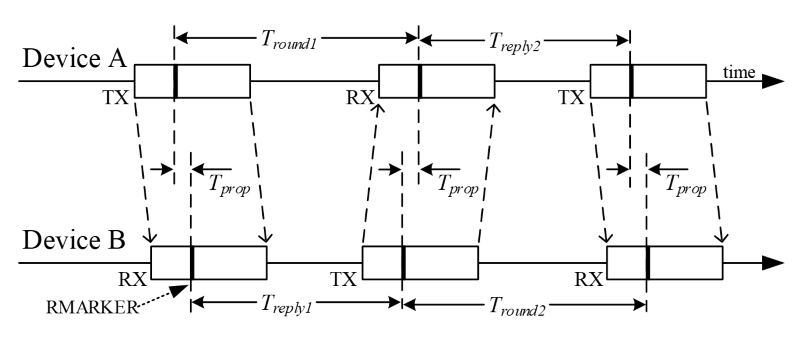GNSS (Global Navigation Satellite System) solutions like GPS or Beidou offers outdoor positioning with an accuracy of about 2-in-3 meters in optimal conditions for consumer devices, and starting in 2022, the upcoming GPS III will bring that down to as low as 1 meter again in consumer devices. For that only works for outdoor positioning, and for indoor positioning we’ve already covered WiFi RTT, and Bluetooth proximity beacons.
The latter has been around for a while, but does not really provide accurate indoor positioning since they’d usually report the distance with less than 10 meters accuracy, and the lag is fairly large with 3 to 6 seconds needed to estimate the distance. The recently released Bluetooth 5.1 specification addresses this issue by enabling location services accurate to within 10 centimeters thanks to a new direction-finding capability made possible with an antenna array.

However, as pointed out by EETAsia, there’s another standard that promises one centimeter accuracy, and nanoseconds resolution times: IEEE 802.15.4z.
The standard is described as follows on IEEE802 website:
The IEEE 802.15.4z Enhanced Impulse Radio(EiR) Task Group is defining a series of PHY enhancements to improve the capabilities of UWB devices using the LRP and HRP PHY clauses. MAC changes to support the PHY changes are also being made. Specifically, this amendment enhances the HRP and LRP UWB PHYs and associated ranging techniques. Areas of enhancement include additional coding and preamble options, improvements to existing modulations to increase the integrity and accuracy of the ranging measurements, and additional information element definitions to facilitate ranging information exchange. The amendment defines MAC changes to support these PHY enhancements. Typical range of the radio is up to 100 meters.
While 802.15.4z is a superior standard to the positioning capabilities of Bluetooth 5.1, I understand the latter does not require a new radio, just the addition of an antenna array, so it does not require new silicon, and will be brought to smartphones faster.
The IEEE 802.15.4z standard for UWB should be in a stable draft form in mid-March 2019, so silicon designs may start around that time, and since companies like Samsung, Huawei, and Apple are involved in the 802.15.4z task group we may expect the new standard to be found in smartphones in the next couple of years. Silicon vendors involved include NXP, 3db access and Decawave all of three already providing UWB (Ultra Wide Band) chips.

Jean-Luc started CNX Software in 2010 as a part-time endeavor, before quitting his job as a software engineering manager, and starting to write daily news, and reviews full time later in 2011.
Support CNX Software! Donate via cryptocurrencies, become a Patron on Patreon, or purchase goods on Amazon or Aliexpress





I wonder if this is more like what the NFL uses to track players on the field. That’s been around for a few years, IIRC.
The is Zebra Motionworks, using Dart ultra wilde band RFID, accurate to 30cm
So … why is this useful again? What social good can come of this?
BTW unless you’re from the usa it’s a metre and a centimetre.
Suppose you have a commercial building containing 10,000 IOT devices and one has died. If you were smart enough to have triangulated its position before it died, you’ll know exactly where to go and replace it.
If you don’t have location information you will have to rely on manually kept records where everything is located, and believe me, those manual records are always wrong.
This UWB is definitely more accurate than phased array, but… you need new silicon. You could do phased array with 802.15.4 too if you wanted to.
I question whether 802.15.4 has a long term future. Bluetooth 5.1 (especially BLE) pretty much does everything 802.15.4 does and every phone in the world comes with Bluetooth and not 802.15.4. The phone support causes Bluetooth to have extremely high volumes on its chips – pushing down the prices.
But are all bluetooth devices going to implement the phased array? This seems like a very purposeful addition to the BT spec for very specific use cases. It’s not like every device is going to support this.
Only one side has to implement the phased array. Usually the fixed receiving station. Phones don’t have to change. The change to the receiving side is not huge, usually four antennas and an antenna switch controlled by a GPIO. Then there is a software updates on both sides. The phone is instructed to send a longer, unvarying carrier (longer preamble) signal during the location phase. The nice, clean carrier makes it easier for the receiver to compute the phase differences.
The UWB stuff requires new hardware on both sides.
The Bluetooth scheme has issues with multipath which are avoided by UWB.
Jon,
First of all pardon my passion for UWB, I’m Mickael from Decawave a UWB chip supplier 😉
Thanks for your good analysis especially the multi path challenge.
BT/BLE array will indeed work well in environments with limited multi path and limited interference from other 2.4GHz devices. The challenge is that there are not that many environments in real life scenarios.
The other challenge is the array. A company like Quupa has developed a very solid solution but the array is much bigger than just 4 antennas and the separation between antennas make the array fairly big (like a 25cm disc).
I’d also like to take to your attention that UWB chips are already available on the Market and even deployed in millions of devices across industrial (asset tracking, robots navigation, safety), automotive (secure communication between key and car, self parking assistance…) and consumer products (location based home automation, lawnmower…).
Not yet the billions of Bluetooth but pretty steep adoption curve and the new standard with big boys in the room shall even further accelerate adoption.
Again, pardon my passion but love this technology.
Regards.
Mickael
Will Bluetooth 6.0 include UWB?
Hi.
I think it will be two separate standards.